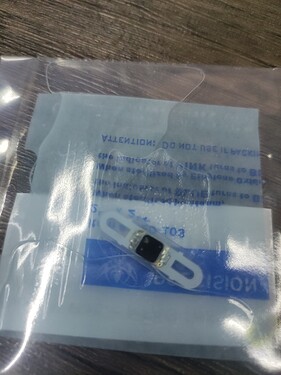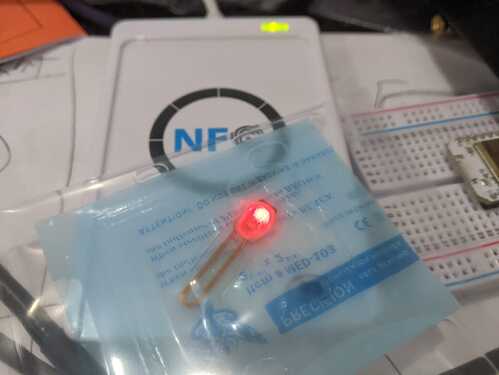As some have noticed I’ve been making some noise about me being torn between old and new “flex wedge” antenna formats.
On the “verge” of Apex launch, Walletmoor being here and payment implant options growing by the day, I get to ask myself what is the difference between the 2 antenna formats?
So here it is a (hopefully) comprehensive suite of tests I ran.
Would be great if other folks with either of those implant form-factors could chip in to add their experiences!
These are the 2 implants I have with me to compare:
FlexMN “wedge”, with new antenna (from now on referred as “new”):
Flex DF2 “wedge”, with old antenna (from now on referred as “old”):
Both are HF, but they are different chips. Worth noting that I do expect the magic Ntag chip on the new antenna to perform worst than a payment conversion on that same antenna.
Still, so far this is only my assumption.
So Let the comparison begin! ![]()
RESILIENCE:
First of all, just by looking at it I can see clearly a lot more robustiness on the connections from the chip to the new antenna than the old one. (I assume a big drive for this coming from the FlexNExT connection issues.)
Yet when I think of a strip/wedge form-factor the necessity of such improvement is directly correlated to the placement:
-
If I place the strip/wedge directly on top of a bone or otherwise non-flexible surface, then the forces acting against the connection are minimal. So a robustiness gain is not so needed. Ex: on top of a metacarpal bone, or on the flat middle of your arm, following the arm’s direction.
-
If I want to place the strip/wedge at a high stretch/mobility place, then this gain in robustness becomes more valuable. The constant stretching of the skin, and therefore of the pocket, will start to apply force against the connections. Hence why added robustness becomes a nice factor. Ex: Finger Phallange, inner side of the wrist.
-
If I am to position the strip/wedge in a perpendicular way to the flat surface, then either (or both) the antenna would be constantly resting in a stress position, or very succeptible to mechanical trauma applying strenght over the connections. Both are very solid arguments in favor of sacrificing range in favour of robustiness, especially since stress force under resting conditions will inevitably lead to contact failure on weak enough soldering/connection. Ex: across the back of the hand. On the wrist, perpendicular to the arm’s length.
Thoughts:
- This gain in robustness might allow the tag to be placed in ways/places where the old antenna could fail.
- This gain allows for added peace of mind when planning your install
- This improvement might be rendered moot depending on your choice of placement and lifestyle.
READ DISTANCE:
Here I’ve measured distance with a digital caliper. Still handheld, so allow for some deviation.
Measured by approaching the tag from above, slowly, until I got a read.
Repeated the approach about 15 times for each and only counted when I got a read.
Utilised an ACR122, a DT KBR reader and my phone.
These are the results:
Reader . . . . . . . NEW . . . . . . . OLD
KBR(DT) . . . . . ~0.3cm . . . . . ~1.5cm
ACR122 . . . . . . ~0.3cm . . . . . ~1.5cm
Phone . . . . . . . . . 0 . . . . . . . . ~1cm
Thoughts:
-
not any significant difference between readers
-
with a phone, I could only get a read on the new antenna after touching it on the phone and rubbing around.
-
There was much more consistency with the old antenna.
-
The new antenna would very seldom read from almost 0.6cm away, but some cases needed to touch the reader or just failed to read.
-
Range seems to be quite different here, but not to a level I really care, personally speaking. If I got to touch the reader, so be it. Although, if I’m thinking of a payment implant, given that most antennas sit behind a touch screen, that might be an issue.
READABILITY TESTS
Here comes what I’m mostly interested in: How easily will I get a read.
This is particularly important if we’re talking about a payment implant, where I sure don’t want to have to be doing weird gestures and jumping around the terminal until it finally goes through or I give up.
For a payment implant I don’t care about range or whatnots nearly as much as I care about consistency.
That said, the objective here is to see how consistent/easy is to get an UID read out of the chip.
I’m only reading UID to minimise the fact that I only have 2 implants in the strip/wedge format, and each one has a different chip in it.
These are the tests I’ve done:
- Approach the tag to the reader, slowly, from above down.
- Swipe the tag through the reader, sideways, with a fast motion. Back and forth movement.
- Swipe the tag through the reader, sideways, with a slow motion. Back and forth movement.
Each of these was repeated 40 times.
All of them passing the chip less than 0.3mm away from the reader.
Each repetition was performed against
- DT’s KBR reader
- ACR122
Results:
Slow Above
Reader . . . . . . New . . . . . . . . . . Old
KBR . . . . . . . . 26 / 40 . . . . . . . . 40/40
ACR . . . . . . . . 14 / 40 . . . . . . . . 40/40
Slow Sideways
Reader . . . . . . New . . . . . . . . . . Old
KBR . . . . . . . . 29 / 40 . . . . . . . . 40/40
ACR . . . . . . . . 21 / 40 . . . . . . . . 40/40
Fast Sideways
Reader . . . . . . New . . . . . . . . . . Old
KBR . . . . . . . . 06 / 40 . . . . . . . . 38/40
ACR . . . . . . . . 06 / 40 . . . . . . . . 36/40
Thoughts:
- Maybe my magic Ntag is just far too slow?
- Even then, the difference here is far too drastic to be completely unrelated to the antenna.
- Maybe it is my old antenna/DF chip that are way too performatic, and that raised my expectation?
- “fast sideways” is roughly as fast as I usually approach my card to a terminal.
- Maybe my new antenna is messed up?
- So far I am really put down by the new antenna. I just hope others are having better results.
“SWEET SPOT”:
Here I messed around with approaching from different angles, moving about,angling the chip, etc…
Whenever I got a read, I would try repeating the same motion back and forth slowly, maintaining angles, about 4 times to check if there was consistency.
Thoughts:
-
old antenna: I didn’t even needed this, since it reads all the time even from weird angles. I can get reads even almost perpendicular to the KBR’s antenna (where even my fobs fail to read).
-
new antenna: both on phone, KBR and ACR, I couldn’t find a single “sweet spot”. it’s just terribly fiddly. Even when I got a position and place where it reads more often than the others (parallel to the back of the D on DT’s KBR), it still fails to read almost every other time while repeating the motion.
PAYMENT TERMINALS:
As the last test, I went out and messed about with some payment terminals in self checkouts at Tesco, Wilko and Saisburys (UK).
I first tested out my old antenna’s blinkie, and noticed that there is a “beep” on the screen and it obviously fails to read the “card”.
Since this was quite consistent, I decided to compare both implants.
-
old antenna: Fairly easy to get the “beep”. To the point I had to change my habit of presenting my card held between index and pinkie, because sometimes it reads my old antenna tag first.

-
new antenna: I figured out that a security guard finds my actions worrying and reaches me faster than I can get a “beep” using the new antenna. I did got a couple beeps, but only after much fiddling and always had to be touching the screen.
Thoughts:
Here, more than in any other test, I believe the chip is playing a larger part than the antenna. but even then the difference is awestriking.
FINAL THOUGHTS
-
I can’t take my tests as canonical since they were performed with different chips!
-
I can see why the new format might be better for most people! And for DT as well, especially since it grants both a lot of security, peace of mind and subsequently a lot less stress!
-
That said, for for myself, given that I always plan my implants with taking the best advantage of the placement as I can, I don’t see any desperate need to increase resilience. Yet I do see a gigantic gain from readability!
-
The range and readability of the old antenna is just insane! With a borrowed Wiegand reader I even got it to read through my hand (like a FlexNExT on an ACR).
-
For everyday use, having so much reliability is a must for me. Both while working at a computer (where I swipe my implant a LOT), and when opening a door while carrying heavy boxes or groceries with both hands… Is essential!
-
Not even caring that much about the range gain (which would be, by itself, enough to make me consider sacrificing resilience), and only thinking from that format being so easy to get a read from… Makes it a no-brainer for me to predilect the “Old” antenna. This is a personal opinion, not a statement of superiority from one format over another!
So… Anyone else fancy chipping in your experiences? ![]()


